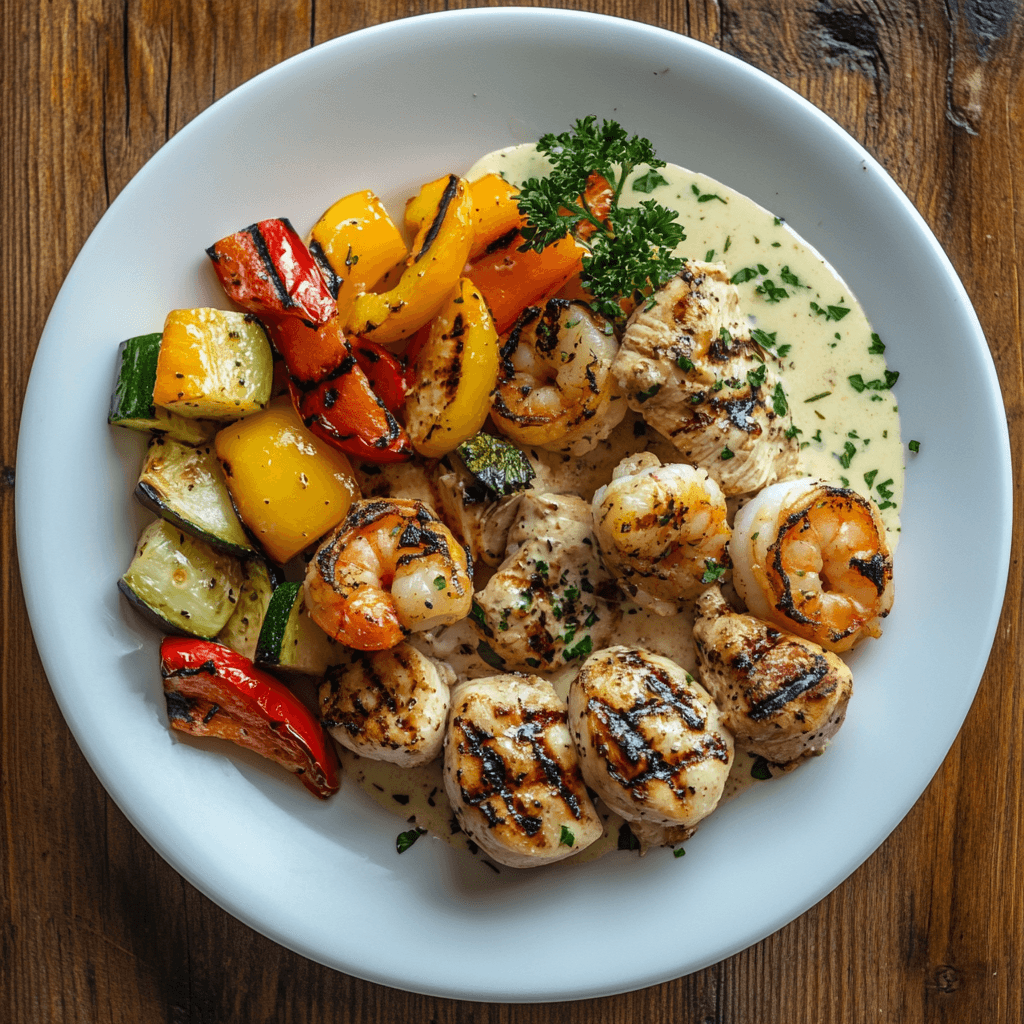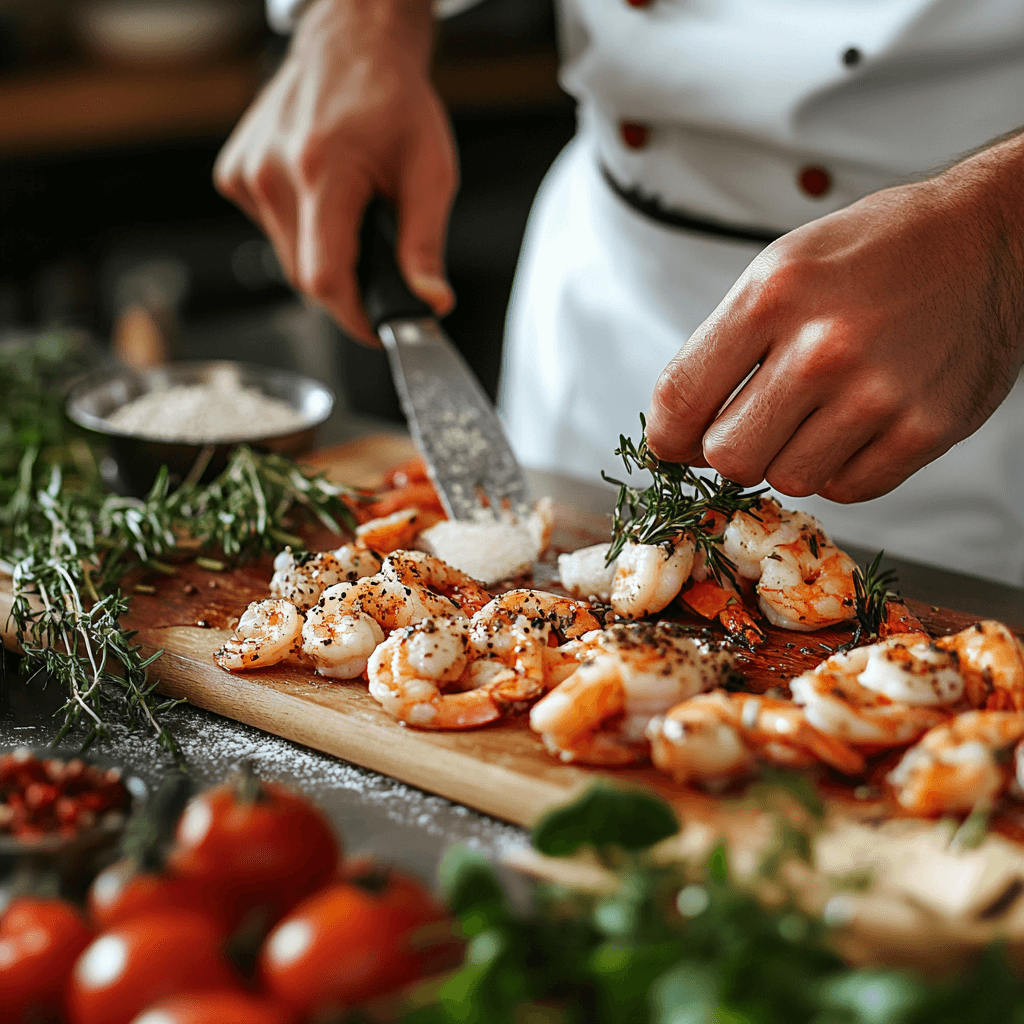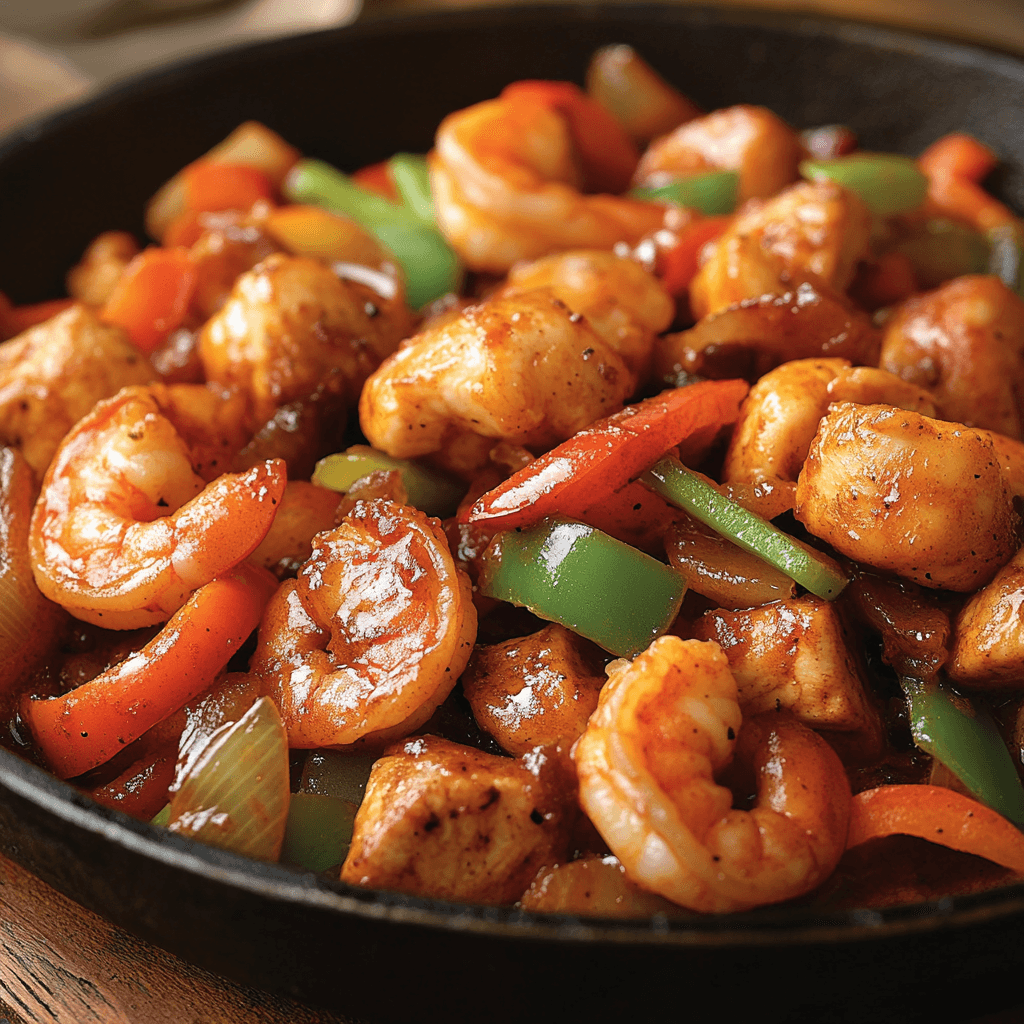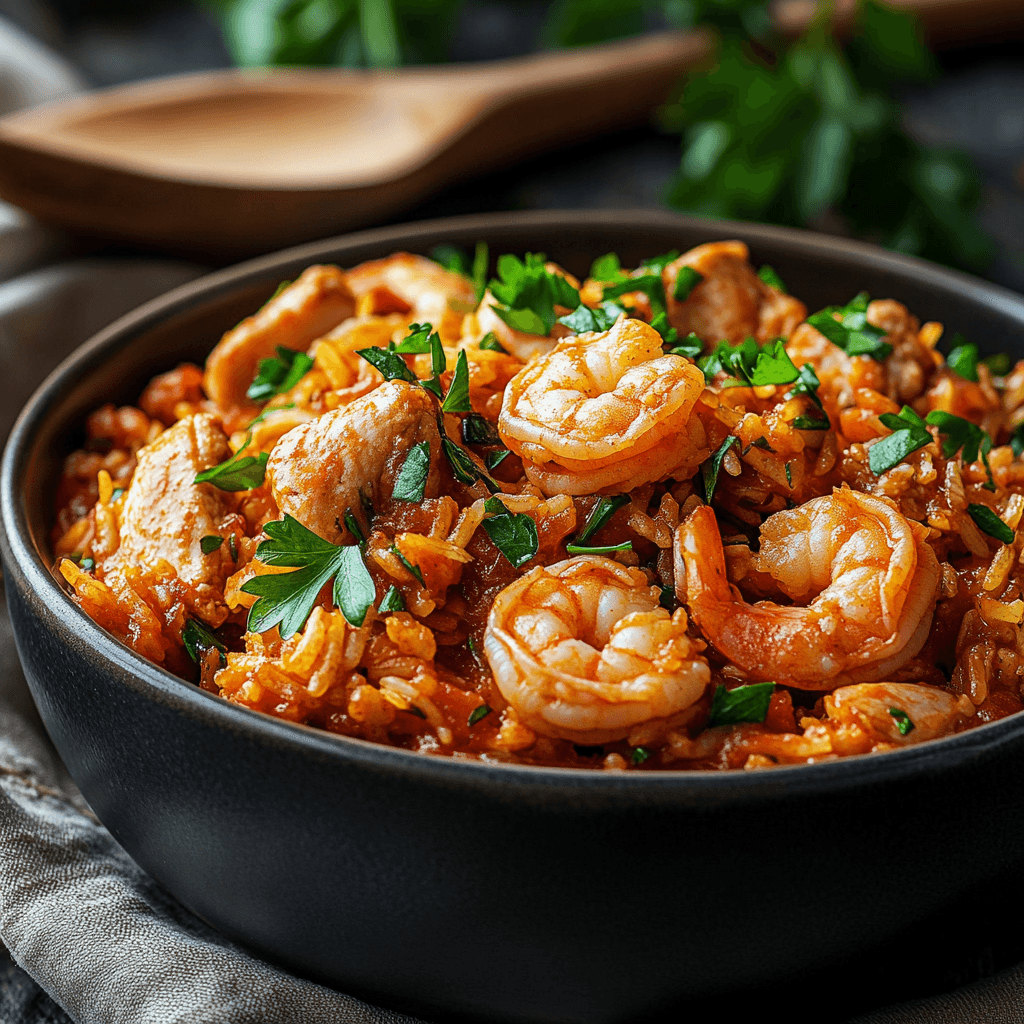Introduction
Why Combine Shrimp and Chicken?

Shrimp and chicken may seem like an unlikely duo at first glance, but their combination creates a culinary harmony that appeals to a wide range of palates. Shrimp, with its sweet and slightly briny flavor, perfectly complements the savory richness of chicken. The contrast in textures—shrimp’s tender juiciness paired with chicken’s firm, hearty bite—makes for a dynamic and satisfying dish.
From a nutritional standpoint, combining these two proteins is also advantageous. Chicken provides a lean source of protein and essential amino acids, while shrimp adds a wealth of omega-3 fatty acids, vitamins, and minerals. Together, they form a nutrient-dense pairing that satisfies both taste buds and dietary needs.
Table of Contents
The Appeal of Surf and Turf Cooking

The concept of surf and turf cooking—pairing land-based proteins like chicken or beef with seafood—has long been celebrated for its luxurious and versatile nature. This style of cooking bridges the best of both worlds: the earthy, robust flavors of land proteins and the fresh, oceanic taste of seafood.
Surf and turf dishes offer endless possibilities for creativity in the kitchen. Whether grilled, sautéed, or baked, the interplay between seafood and land proteins can be tailored to suit various cuisines and flavor profiles. Additionally, this pairing lends itself well to a variety of occasions, from casual family dinners to upscale gourmet experiences. It’s no wonder that the combination of seafood and poultry, remains a beloved staple in the world of surf and turf cooking.
Safety Concerns in Cooking
Understanding Cooking Temperatures
Cooking temperatures are a critical aspect of food safety, especially when preparing proteins like seafood and poultry. Proper cooking ensures harmful bacteria and pathogens, such as Salmonella or Vibrio, are destroyed, reducing the risk of foodborne illnesses.
- Chicken: The USDA recommends cooking chicken to an internal temperature of 165°F (74°C) to ensure it is safe for consumption. Use a food thermometer to check the thickest part of the meat, avoiding bones, for an accurate reading.
- Shrimp: Shrimp are more delicate and cook quickly. They are safe to eat when they turn opaque and have a firm texture. This typically occurs at an internal temperature of 120°F (49°C), though many cooks rely on visual cues to judge doneness.
Adhering to these guidelines is essential to produce a meal that is both delicious and safe to eat.
Risks of Undercooking Shrimp and Chicken
Undercooking this protein pairing can pose significant health risks due to the potential presence of harmful microorganisms.
- Chicken: Undercooked chicken is a common source of Salmonella and Campylobacter infections. Symptoms of these infections can include nausea, vomiting, diarrhea, and fever. Consuming raw or undercooked chicken can result in severe illness, particularly for vulnerable groups like children, pregnant women, and those with weakened immune systems.
- Shrimp: Raw or undercooked shrimp can harbor bacteria such as Vibrio and viruses like norovirus, which are common in seafood. These pathogens can lead to gastrointestinal symptoms, including stomach cramps and vomiting. In rare cases, severe infections can occur, especially for individuals with compromised immunity.
To minimize these risks, always use proper cooking techniques, maintain clean kitchen practices, and store raw proteins at appropriate temperatures before cooking. Taking these precautions ensures that your meals are both flavorful and safe to enjoy.
Flavor Harmony: Do Shrimp and Chicken Work Together?

Balancing Seafood and Poultry Flavors
this protein pairing may hail from different culinary realms, but their flavors complement each other remarkably well when balanced thoughtfully. Shrimp’s sweet, slightly briny taste provides a refreshing contrast to chicken’s mild, savory flavor. This pairing allows both proteins to shine, especially when seasoned or cooked in a way that enhances their natural qualities.
The key to achieving balance lies in choosing cooking techniques and ingredients that do not overpower one protein while elevating the other. For example, sautéing or grilling both this protein pairing together allows their flavors to meld harmoniously, while sauces or broths can act as a unifying element.
Choosing Complementary Marinades and Spices
The versatility of this protein pairing makes them ideal for a wide range of marinades and spice blends. To create a cohesive dish, it’s important to select seasonings that enhance the flavors of both proteins without overwhelming either.
- Marinades: Citrus-based marinades, such as lemon or lime with olive oil and herbs, work well for both this protein pairing, as the acidity brightens their flavors. Soy sauce-based marinades with ginger and garlic add a savory, umami depth that suits both proteins.
- Spices: Paprika, cayenne, and cumin add warmth and a touch of smokiness, making them ideal for grilling or roasting. Fresh herbs like parsley, cilantro, and basil can be used as finishing touches to complement the dish’s overall flavor.
Careful seasoning not only enhances the individual qualities of this protein pairing but also ensures they work together seamlessly in a dish.
Popular Recipes That Combine Shrimp and Chicken

Combining shrimp and chicken in a single dish has long been a favorite approach in cuisines worldwide. Here are some popular recipes that showcase their harmonious pairing:
- Shrimp and Chicken Jambalaya: A Louisiana classic, this hearty dish combines shrimp, chicken, and smoky sausage in a spicy tomato-based rice dish, delivering bold flavors and rich textures.
- Surf and Turf Stir-Fry: Quick and versatile, this stir-fry blends shrimp and chicken with vegetables in a savory soy-ginger sauce, perfect for a balanced weeknight meal.
- Shrimp and Chicken Alfredo: Creamy and indulgent, this pasta dish features this protein pairing in a luscious garlic Alfredo sauce, offering a satisfying mix of textures.
- Grilled Shrimp and Chicken Skewers: Marinated in a blend of citrus, garlic, and spices, these skewers are a perfect option for outdoor grilling, creating a smoky, caramelized flavor.
These dishes highlight the versatility and compatibility of shrimp and chicken, proving that this duo can elevate any meal into a flavorful and satisfying experience.
Methods to Cook Shrimp and Chicken Together
Stir-Frying
Stir-frying is a quick and versatile method for cooking shrimp and chicken together, making it ideal for busy weeknights. This method involves cooking both proteins at high heat with minimal oil, allowing them to retain their natural flavors while blending with seasonings and vegetables.
- Tips: Start by cooking the chicken first, as it takes longer to cook through. Once the chicken is nearly done, add the shrimp to the pan. Their quick cooking time ensures they won’t become rubbery or overcooked.
- Seasonings: Soy sauce, ginger, garlic, and a splash of sesame oil are popular additions to stir-fry dishes, enhancing the natural flavors of both proteins.
Grilling
Grilling brings out smoky and caramelized flavors in both shrimp and chicken, making it a perfect method for outdoor cooking. Whether on skewers or directly on the grill, this method creates a delightful char that enhances the taste of both proteins.
- Preparation: Marinate the shrimp and chicken in a complementary blend, such as citrus and herbs or a spicy barbecue sauce. Thread them onto skewers for easy handling or cook them separately to manage their different cooking times.
- Tips: Since shrimp cook faster than chicken, consider pre-cooking the chicken slightly or placing it on a hotter part of the grill.
Baking or Sheet Pan Recipes
Baking seafood and poultry, together on a sheet pan is a hands-off method that’s perfect for one-pan meals. This approach ensures even cooking and allows flavors to meld as they bake.
- Preparation: Arrange the seafood and poultry, with vegetables like bell peppers, onions, and zucchini on a single sheet pan. Drizzle with olive oil and sprinkle with seasonings such as garlic powder, paprika, and thyme.
- Tips: Begin baking the chicken first, then add the shrimp during the last 5–7 minutes of cooking to prevent overcooking.
Soups and Stews
Soups and stews offer a comforting and flavorful way to combine shrimp and chicken. These dishes allow the proteins to infuse the broth with their distinct flavors while absorbing the seasonings from the liquid.
- Examples: Dishes like gumbo, cioppino, or Thai coconut curry often feature shrimp and chicken together, creating a rich, hearty base complemented by spices and vegetables.
- Tips: Add the chicken early in the cooking process to allow it to become tender, and introduce the shrimp in the final minutes to keep them succulent.
By choosing the right method and timing, you can create delicious dishes that showcase the complementary flavors of seafood and poultry, whether you’re stir-frying for speed, grilling for smokiness, baking for simplicity, or simmering for comfort.
Nutritional Benefits of Combining Shrimp and Chicken
Protein Content and Nutritional Balance
Combining seafood and poultry, in a meal creates a protein-rich dish that provides a well-rounded nutritional profile.
- Shrimp: A 3-ounce serving of shrimp contains about 20 grams of high-quality protein, along with essential nutrients like omega-3 fatty acids, selenium, and iodine, which support brain function and immune health.
- Chicken: A 3-ounce serving of chicken breast offers approximately 26 grams of protein and is an excellent source of vitamins B6 and B12, phosphorus, and niacin, which contribute to energy metabolism and cellular health.
Together, seafood and poultry, deliver a complementary mix of nutrients, making them ideal for muscle repair, growth, and overall health.
Calorie Considerations
One of the benefits of pairing shrimp and chicken is their relatively low calorie content compared to other proteins, allowing for indulgent yet health-conscious meals.
- Shrimp: Shrimp are low in calories, with about 84 calories per 3-ounce serving. Their low fat content makes them a great choice for those looking to reduce caloric intake.
- Chicken: Chicken breast is similarly lean, providing about 140 calories per 3-ounce serving when skinless. Darker cuts of chicken, like thighs, are slightly higher in calories but offer more flavor.
When cooked using low-fat methods, shrimp and chicken can contribute to satisfying meals that are friendly to weight management goals.
Tips for Healthier Preparation Methods
To maximize the nutritional benefits of shrimp and chicken while minimizing unhealthy fats and calories, consider these healthier preparation techniques:
- Grilling: Use marinades with olive oil, lemon juice, and fresh herbs instead of heavy sauces. Grilling imparts smoky flavors without the need for excess fat.
- Baking or Roasting: Roast shrimp and chicken with a variety of vegetables on a sheet pan. Use minimal oil and season with spices for a flavorful yet light dish.
- Steaming or Boiling: For soups or stews, avoid cream-based broths and opt for clear or tomato-based ones. Add aromatic spices like ginger, turmeric, or cilantro to enhance flavor without extra calories.
- Avoid Breaded or Fried Methods: Instead of frying, use techniques like oven-baking with a breadcrumb coating for a crispy texture without the added fat.
By focusing on these healthier methods, you can create shrimp and chicken dishes that are not only delicious but also nutritionally balanced and calorie-conscious.
FAQs
Can You Marinate Shrimp and Chicken Together?
Yes, seafood and poultry, can be marinated together if the marinade complements both proteins. However, since shrimp are more delicate, they require a shorter marinating time, typically 15–30 minutes, to avoid becoming overly salty or mushy. If marinating both together, it’s best to separate the shrimp earlier and allow the chicken to marinate longer for maximum flavor absorption.
Is It Safe to Eat Shrimp and Chicken Cooked in the Same Pan?
Yes, it is safe to cook seafood and poultry, in the same pan, provided that both are cooked to their recommended internal temperatures. Start cooking the chicken first, as it takes longer, and add the shrimp later to ensure neither is undercooked. Always check doneness with a food thermometer for safety.
Do Shrimp and Chicken Need Different Cooking Times?
Yes, shrimp and chicken require different cooking times. Shrimp cook quickly, usually in 3–5 minutes, while chicken needs more time, depending on the cut and thickness. For chicken breast, this could be 15–20 minutes. Adjust your cooking sequence to prevent overcooking the shrimp or undercooking the chicken.
Can Shrimp and Chicken Be Cooked Together in Soups?
Absolutely! seafood and poultry, work beautifully in soups and stews. Add the chicken early in the cooking process, allowing it to tenderize and infuse flavor into the broth. Introduce the shrimp in the final 5–10 minutes of cooking to prevent them from becoming rubbery.
How Do You Know When Shrimp and Chicken Are Done Cooking?
- Shrimp: Shrimp are done when they turn opaque and their flesh becomes firm, usually at an internal temperature of 120°F (49°C).
- Chicken: Chicken is safe to eat when the internal temperature reaches 165°F (74°C), and its juices run clear when cut.
Using a food thermometer ensures both proteins are properly cooked without guesswork.
What Are Some Examples of Dishes Combining Shrimp and Chicken?
Here are a few delicious dishes that highlight the combination of seafood and poultry, Cooking:
- Jambalaya: A flavorful rice dish featuring seafood and poultry, and sausage in a spicy tomato-based sauce.
- Shrimp and Chicken Stir-Fry: A quick and healthy dish with vegetables and a savory soy-ginger sauce.
- Thai Coconut Curry: A creamy and aromatic curry with shrimp, chicken, and vegetables in a coconut milk base.
- Grilled Surf and Turf Skewers: Marinated shrimp and chicken cooked together on skewers.
- Chicken and Shrimp Alfredo: A rich pasta dish with shrimp and chicken in a creamy garlic sauce.
These dishes showcase the versatility and appeal of combining seafood and poultry, in creative ways.
Conclusion
Key Takeaways
- Flavor Compatibility: Shrimp and chicken complement each other with their contrasting textures and flavors, making them an excellent pairing for various dishes.
- Nutritional Benefits: Together, shrimp and chicken provide a high-protein, nutrient-rich combination that supports muscle growth and overall health while remaining low in calories when prepared with healthy cooking methods.
- Versatile Cooking Methods: From stir-frying and grilling to baking and soups, there are numerous ways to cook shrimp and chicken together, offering flexibility for diverse cuisines and occasions.
- Cooking Safely: Ensuring proper cooking temperatures—165°F (74°C) for chicken and 120°F (49°C) for shrimp—is essential for both safety and taste.
Final Thoughts on Cooking Shrimp and Chicken Together
Cooking shrimp and chicken together is not only practical but also a creative way to diversify your meals. Whether you’re preparing a quick stir-fry for a busy weeknight or an indulgent surf-and-turf-inspired dish for a special occasion, this duo offers endless possibilities for culinary exploration. With attention to cooking techniques, flavors, and food safety, seafood and poultry, can transform into dishes that are both delicious and nutritious. Enjoy the journey of experimenting with this dynamic pairing!
